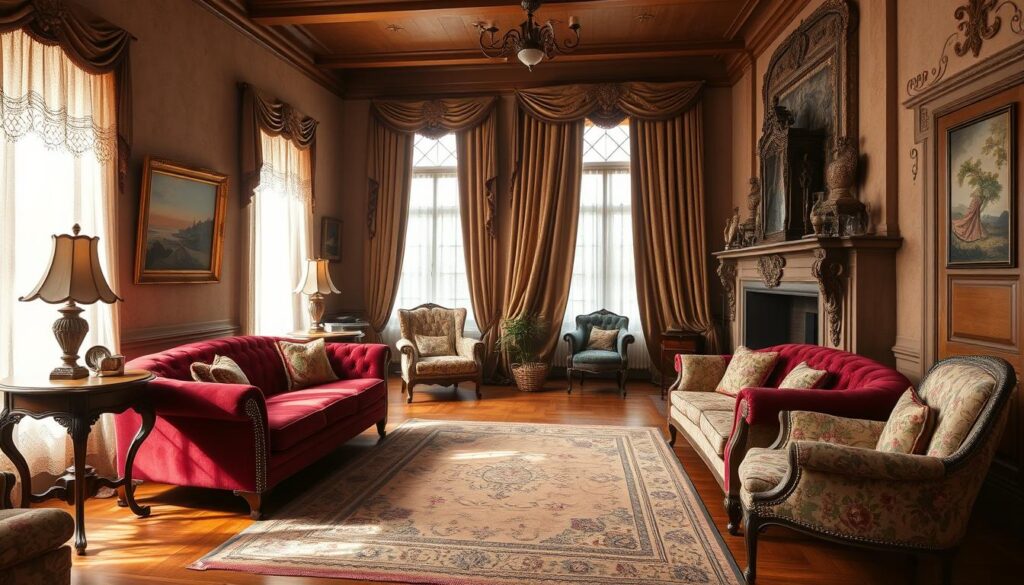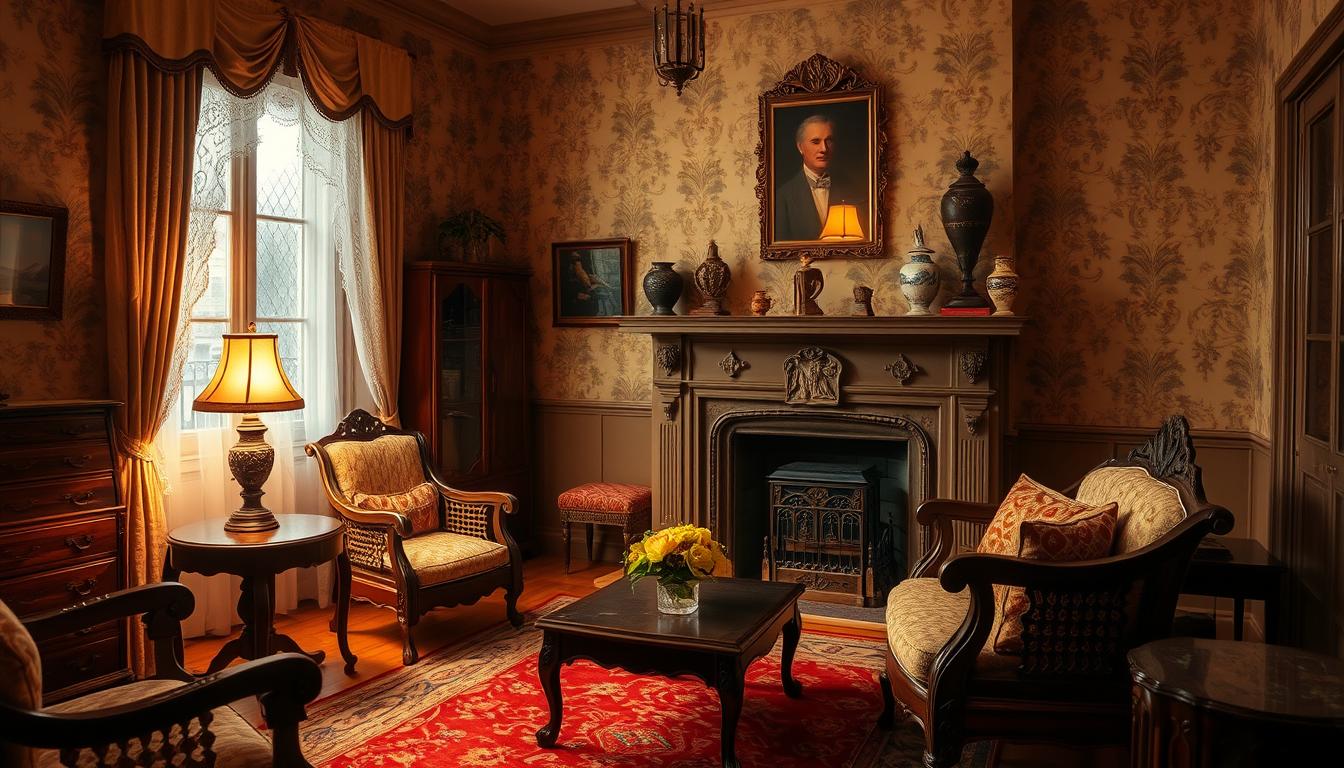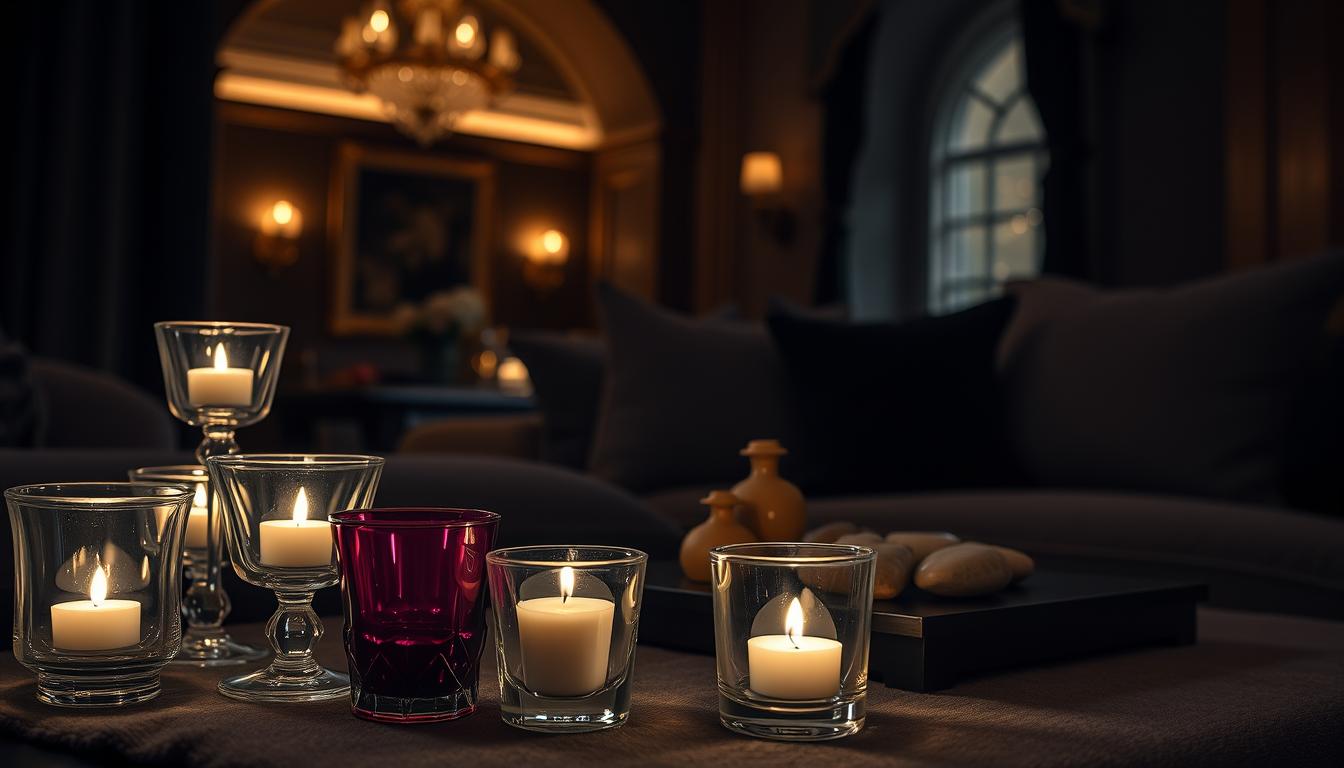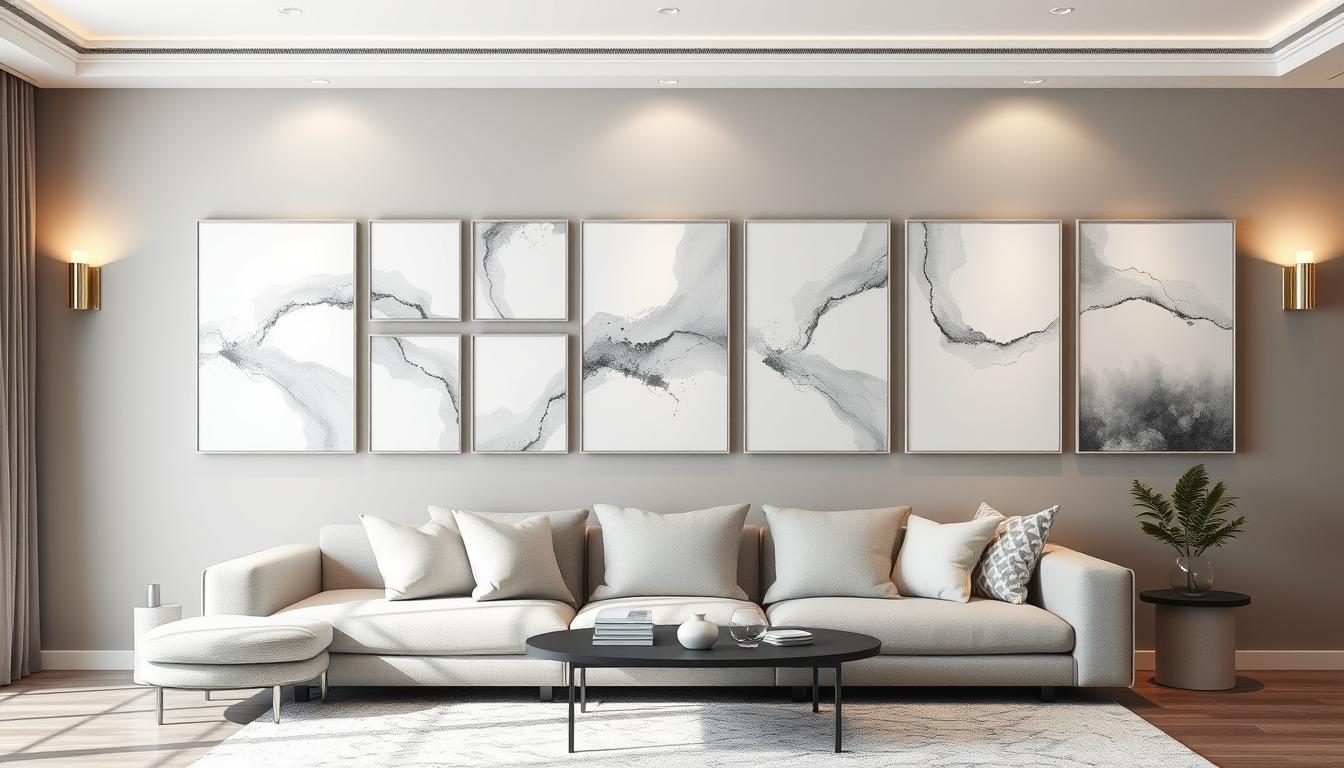The early 20th century was a time of big change in vintage home decor. New design styles and technologies came into play. During this time, craftsmanship and attention to detail were highly valued. This greatly influenced the early 20th century design.
Exploring 1910 home interiors takes us into architectural styles, color palettes, and furniture of the era. Our guide offers timeless design tips. These tips help you bring the authentic look of the past into your home.
Key Takeaways
- Understand the architectural style of the 1910 era
- Learn about the characteristic color palettes
- Discover the types of furniture and textiles used
- Explore lighting and flooring options
- Find out how to achieve an authentic vintage look
Understanding the 1910 Architectural Style
Knowing the 1910 architectural style is key for fixing up old homes. These homes were big and detailed, showing off the classic look of their time.
We’ll look at what makes the 1910 style special. This includes the materials and standout features.
Key Characteristics of 1910 Homes
1910 homes had fancy moldings, hardwood floors, and fancy fixtures. These added to their beauty and class.
Popular Materials Used
1910 homes were built with many materials, like:
- Hardwood for floors and furniture
- Marble for fireplaces and decorations
- Pressed metal for ceilings and cornices
Notable Architectural Features
Some key features of 1910 homes are:
| Feature | Description |
|---|---|
| Intricate Moldings | Detailed woodwork on ceilings and walls |
| Hardwood Floors | Strong and good-looking floors |
| Ornate Fixtures | Decorative lights and hardware |
Understanding these traits helps us value the 1910s’ classic architecture. It guides us in restoring these homes to their former glory.
Color Palettes Inspired by 1910 Interiors
1910 interiors are known for their timeless beauty. They mix neutral tones with accent colors. This creates a warm and inviting feel in homes.
Neutral Tones and Earthy Shades
Neutral tones and earthy shades were key in 1910. Beige, taupe, and moss green were popular. They made homes calm and natural.
These colors also brought the outdoors in. This was a big design idea back then.
Accent Colors in 1910 Décor
Accent colors added depth and character to 1910 interiors. Rich colors like burgundy, navy blue, and golden yellow were used. They added elegance and sophistication.
These colors were used in period-appropriate furnishings and decor. They made the space look even better.
How to Choose the Right Colors
Choosing colors for your home is about understanding 1910 design. If you’re doing retro house remodeling, pick colors that match the era. Think about your home’s style and surroundings.
This way, you can create a look that’s both authentic and your own. It’s a way to honor the original design while adding your own touch.
To start, pick neutral tones as your base. Then, choose a few accent colors that match your decor. This will help you create a balanced and harmonious space that celebrates 1910 design.
Furniture Styles That Defined the Era
The 1910s were a key time for furniture design. This era mixed old techniques with new trends. Furniture from then focused on quality, lasting value, and beauty.
Iconic Pieces from the 1910s
The 1910s brought us iconic furniture pieces. Armchairs and sofas, made from oak and mahogany, were detailed and strong. They were not just useful but also made homes look great.
Materials and Craftsmanship
Furniture from the 1910s used top-notch materials and skill. Craftsmen of the time were proud of their work. They made sure each piece was not just pretty but also lasted long. Solid woods, detailed carvings, and comfy upholstery were key features.
| Material | Characteristics | Common Uses |
|---|---|---|
| Oak | Durable, prominent grain | Tables, chairs, beds |
| Mahogany | Rich color, fine grain | Sofas, armchairs, cabinets |
Blending Vintage and Modern
Mixing old furniture with new can make a space unique. Start with a few vintage pieces, like an antique armchair or a vintage coffee table. Then, add modern furniture that matches in style or material.
It’s key to balance old and new furniture. Think about the size, color, and texture of each piece. This way, you can make a space that feels both old and new, showing off the best of both.
The Role of Textiles in 1910 Homes
Textiles were key in 1910 homes, adding warmth and character. The fabric, pattern, and texture greatly influenced a room’s look.
Fabrics Popular in 1910
In the 1910s, velvet, linen, and silk were top choices. Velvet was prized for its luxurious feel, used for furniture and curtains. Linen and silk were loved for their durability and elegance.

Patterns and Textures That Stand Out
The 1910s were all about detailed patterns and textures. Damask, tapestry, and embroidered fabrics were big, adding depth and interest. These often featured floral and geometric designs typical of the time.
To bring these textiles into your home, use vintage or inspired fabrics for furniture, drapes, or pillows. Combining different textures, like silk and linen, adds depth to your decor.
Incorporating Textiles in Today’s Design
When adding 1910s textiles to modern design, mix old with new. Here’s how:
- Use vintage fabrics for standout pieces, like chairs or ottomans.
- Update old furniture with period patterns through reupholstering.
- Blend antique textiles with modern ones for a unique look.
| Fabric | Characteristics | Modern Use |
|---|---|---|
| Velvet | Luxurious, soft, and dense | Upholstery, accent pillows |
| Linen | Durable, natural, and textured | Drapery, upholstery |
| Silk | Elegant, smooth, and lustrous | Accent pillows, wall hangings |
By carefully adding 1910s textiles to your decor, you can create a rich, layered look. This honors the past while embracing today’s style.
Lighting Fixtures of the Early 20th Century
The early 20th century brought big changes in lighting design. Fixtures became more ornate and decorative. They were made with high-quality materials and craftsmanship. This made them both functional and beautiful.
Types of Lighting Commonly Used
Many types of lighting were popular back then. Chandeliers, sconces, and pendant lights were favorites. Chandeliers added elegance to dining rooms and entryways. They were often made from brass and crystal.
Sconces were used for ambient lighting in hallways and living areas. Their designs ranged from simple to ornate. This let homeowners match their décor.
Modern Reproductions of Vintage Fixtures
Want to add early 20th-century elegance to your home? Look into reproductions of vintage fixtures. These modern pieces keep the original design’s charm but use today’s materials and techniques.
When picking a reproduction, think about the original’s style and material. Also, how it will fit with your décor. Reproduction lighting is a budget-friendly way to get an authentic look without the high cost of antiques.
Tips for Choosing Lighting
Choosing the right lighting fixture is key. Think about the room’s purpose, the ambiance you want, and your décor. For an early 20th-century look, go for fixtures with detailed designs and quality materials.
- Consider the fixture’s size compared to the room.
- Match materials and finishes with your décor.
- Decide on the lighting type you need: ambient, task, or accent.
By picking the right lighting, you can improve your home’s look. And you’ll honor the design of the early 20th century.
Flooring Choices for 1910 Interiors
Restoring a 1910 home to its original glory means making smart flooring choices. Flooring was key in achieving an authentic Edwardian look. High-quality materials from that era have lasted for many years.

Popular Flooring Materials
In the 1910s, hardwood flooring was a top pick for homeowners. Oak, maple, and pine were favored for their durability and beauty. They were often waxed or oiled to protect and enhance their look.
Other materials like marble and terrazzo were used in entryways for a grand look. Tile flooring, including encaustic cement tiles, was also popular for its beauty and durability.
Maintenance Tips for Vintage Floors
Caring for vintage floors needs a gentle touch. For hardwood floors, regular sweeping or vacuuming is key. Avoid harsh chemicals and too much water to protect the finish and wood.
“The key to preserving vintage flooring is to maintain its original character while ensuring it remains functional and safe for daily use.”
Tile floors benefit from regrouting and sealing to keep them looking good. Marble or terrazzo floors need quick cleaning to avoid stains.
Current Trends in Flooring
While keeping it authentic is important, adding modern touches can make 1910 interiors more livable. Using reclaimed wood for flooring adds history and charm.
Another trend is to restore original flooring instead of replacing it. This keeps the home’s history intact, saves waste, and can save money.
By knowing the flooring options of the 1910 era and using modern care and restoration, homeowners can blend old charm with modern comfort.
Wall Treatments in 1910 Home Design
Wall treatments in 1910 homes were more than just practical. They were also decorative, showing off the era’s style. The right treatment could make a room feel more luxurious and refined.
Types of Wall Coverings
In the 1910s, many wall coverings were used, each with its own charm. Wallpaper was a hit, with detailed patterns that added room depth. Paneling and wainscoting brought texture and interest.
Some chose more elaborate options like hand-painted murals or stenciling. These allowed for personal touches, making spaces truly unique.
Decorative Techniques from the Era
The 1910s saw a comeback in decorative techniques. Molding and trim framed doorways and windows, creating a smooth flow. They added elegance to walls.
Raised paneling became popular, giving walls a three-dimensional look. It was often paired with chair rails for a unified design.
Contemporary Applications of Vintage Styles
Today, vintage styles are back in home decor. Using period-appropriate furnishings and coverings can make spaces feel both old and new.
For retro house remodeling, adding vintage touches like wallpaper or molding is a great tribute. It also allows for modern twists.
By using antique interior inspiration from the 1910s, homes become not just beautiful but also full of history and character.
Achieving an Authentic 1910 Look
To get an authentic 1910 look in your home, you need to know the design rules of that time. The early 20th century saw big changes in interior design. These changes came from the Arts and Crafts movement and new materials and tech.
The 1910s mixed old craftsmanship with new ideas. This made interiors elegant and useful. To get this look, focus on finding the right vintage decor and mixing old styles well.
Tips for Sourcing Vintage Décor
Finding vintage decor is key to an authentic 1910 look. Look in antique stores, estate sales, and online for real pieces from then.
- Find furniture with detailed work, like carved wood and inlaid designs.
- Choose lighting that shows the era, like bronze or brass lamps with fancy shades.
- Add vintage textiles, like tapestries and embroidered linens, for depth and character.
As interior design expert, Oscar Wilde, once said,
“To live in a beautiful house is a necessity for happiness.”
This quote shows how important it is to have a beautiful and real space.
Mixing Period Styles
Making a space both authentic and livable is important. Mixing old styles with new comforts and personal touches can create a unique look. This look honors the 1910s while adding modern touches.
| Vintage Element | Modern Counterpart | Result |
|---|---|---|
| Ornate wooden furniture | Minimalist decor | Balanced elegance and simplicity |
| Vintage textiles | Contemporary patterns | Richness with a modern twist |
| Antique lighting fixtures | Modern LED bulbs | Authentic look with energy efficiency |
Creating a Cohesive Space
Making a space cohesive means balancing old and new. Make sure the decor and furniture work well together.
Think about the color, texture, and size of your space’s elements. A consistent color scheme and mixing textures can unite different pieces.
By knowing the 1910 design principles, finding the right vintage decor, and mixing styles carefully, we can make a space that’s both real and welcoming. This way, we honor the past while enjoying today.
Preserving and Restoring 1910 Homes
Keeping the charm of 1910 homes alive means understanding their history. When we renovate these homes, we must keep their original look and feel. This includes their unique Edwardian interior style.
Maintaining Original Features
Keeping the home’s original details is key to a true restoration. This includes things like fancy moldings, wooden floors, and unique lights. This way, the home’s classic beauty stays intact.
Common Challenges in Restoration
Restoring old homes can be tough. We face issues like old electrical systems, water damage, and structural problems. But, we must fix these while keeping the home’s history and charm.
Resources for Homeowners
There are many resources to help homeowners restore their homes. Local groups, online forums, and experts in historic home renovation are all there to help. They offer valuable advice and support every step of the way.



